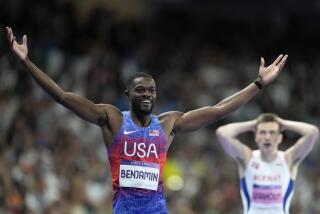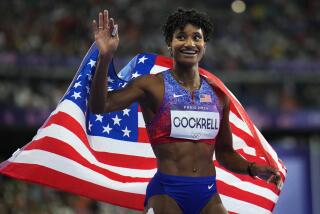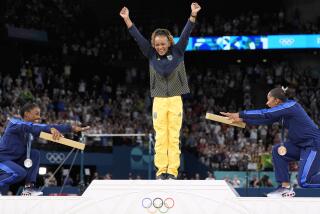Jackie Joyner-Kersee : Record-Setting Track Star Strives to Get Even Better
SAN DIEGO — Jackie Joyner-Kersee, one of the brightest stars on the women’s track circuit, laughed at such a suggestion.
“Who, me?” she said. “There are a lot of good athletes out there. I just like what I do, and I keep trying to get better. When I don’t win, I want to know why.”
Joyner-Kersee, a 24-year-old UCLA graduate, holds the world record in the heptathlon, American records both indoors and outdoors in the long jump, and ranks with the world’s best in the hurdles.
Joyner-Kersee will compete in the long jump and the 60-meter hurdles tonight at The Times/GTE Indoor Games at Los Angeles and in the long jump at the Michelob Invitational indoor meet Sunday in the San Diego Sports Arena. The women’s hurdles are not being contested in the San Diego meet.
In spite of her success, she is obsessed with doing the little things she needs to do to get better.
Discussing her hurdling form, she said: “I tend to block my legs with my arms. I’m beating people on the ground with my speed, but they’re beating me over the hurdles. You know how hard it is to break a bad habit. Well, I’ve got to improve my technique.”
If Joyner-Kersee improves her technique just a tad, she may be adding hurdling records to her accomplishments in the heptathlon and long jump. She is undefeated in four races indoors this winter, and has twice turned in the third best time ever for an American woman at 50-meters--6.91 seconds. Her best 60-yard time, 7.51, is close to the American indoor record of 7.36.
“I’ve been getting better each time,” she said.
In the long jump, Joyner-Kersee has two victories in three starts, having lost to Carol Lewis by one inch Feb. 7 in Dallas. She avenged that loss last Saturday in East Rutherford, N.J. Her season best had been 21-feet 11 3/4-inches in the Sunkist Invitational Jan. 16 at the Los Angeles Sports Arena.
However, she is not at all satisfied with performance in the long jump.
“My American records are 22-10 1/2 indoors and 23-9 outdoors,” she said. “My goals are 23 feet indoors and 24 feet outdoors. I don’t see any reason why I can’t reach both of them.”
In the last year, Joyner-Kersee has twice bettered the world heptathlon record and set the American outdoor long jump record. She was named the outstanding athlete in the Goodwill Games at Moscow and athlete of the year by Track and Field News.
She also is a finalist for the Sullivan Award, which will be given to the country’s outstanding amateur athlete Monday. Among her rivals are Vinny Testaverde, the Heisman Trophy winner, and Debi Thomas, former world figure skating champion.
The one honor Joyner-Kersee wants above all others is the Olympic gold medal in the heptathlon next year at Seoul. Hampered by a hamstring injury, she finished second in the 1984 games--and fifth in the long jump.
The heptathlon is the women’s counterpart of the decathlon. It consists of the 100-, 200- and 800-meter runs, 100-meter hurdles, high jump, long jump, shotput and javelin throw.
“I lost by five points in the last event, the 800,” she said. “I thought I had it won, but Glynis Nunn of Australia ran a better 800 and beat me out. That was her last competition, so I haven’t had a shot at her since. I feel like I could win in ’88.”
Joyner-Kersee began working on the heptathlon in November, but she’s now getting serious about her training, especially concentrating on her weakest events--the shotput, javelin and 800.
“A lot of times the decision comes down to the 800. What happened to me in ’84 is a good example,” she said. Last year in Moscow, needing a 2:14 in the 800 to break the world record, she ran a 2:10.6 to give her 7,148 points. In Houston, she needed a 2:10 and ran a 2:09 for 7,158 points.
“You need strength to win such a grueling event, and thanks to weight training I’m stronger than I was in ‘84,” said Joyner-Kersee, 5-10 and 152 pounds. “In my freshman year at UCLA, I weighed 150 but I was fat. I had no muscle tone at all. Finally, I got really serious and stopped eating junk food.
“If you can improve in all eight events, you can pick up 7 to 10 points in each, and that adds up. I had only 5,380 points in the Olympics, but they’ve changed the scoring system since then.”
Joyner-Kersee believes that such drawn-out and widely scattered events as the heptathlon and decathlon are only beginning to generate public interest.
“People have always been used to watching the glamour events,” Joyner-Kersee said. “They focus on events like the sprints, the hurdles and the mile, because they’re run on the track. In the heptathlon, it’s not over in 13 seconds, like in the hurdles, so fans get distracted. They would rather see the 100 meters than the high jump.
“The turning point came when Jane Frederick was the dominant force in the heptathlon. All I did was make a greater impact by beating the Eastern-bloc athletes and setting a world record in Moscow. Because I did it there and then came back and broke the record again in Houston, the American people can relate to it.”
Joyner-Kersee grew up in East St. Louis, Ill., a town that she describes as rough. She did not compete in the heptathlon at Lincoln High School, so she got her first exposure to all-round competition at UCLA. She also played basketball at UCLA.
“The only event I had to learn was the javelin,” she said. “They added that while I was in college, and the first time I picked up a javelin I speared myself in the head. I thought all I had to do was grab it and throw it. I wasn’t hurt, but I knew then and there that I had to spend some time on it.”
More to Read
Go beyond the scoreboard
Get the latest on L.A.'s teams in the daily Sports Report newsletter.
You may occasionally receive promotional content from the Los Angeles Times.










